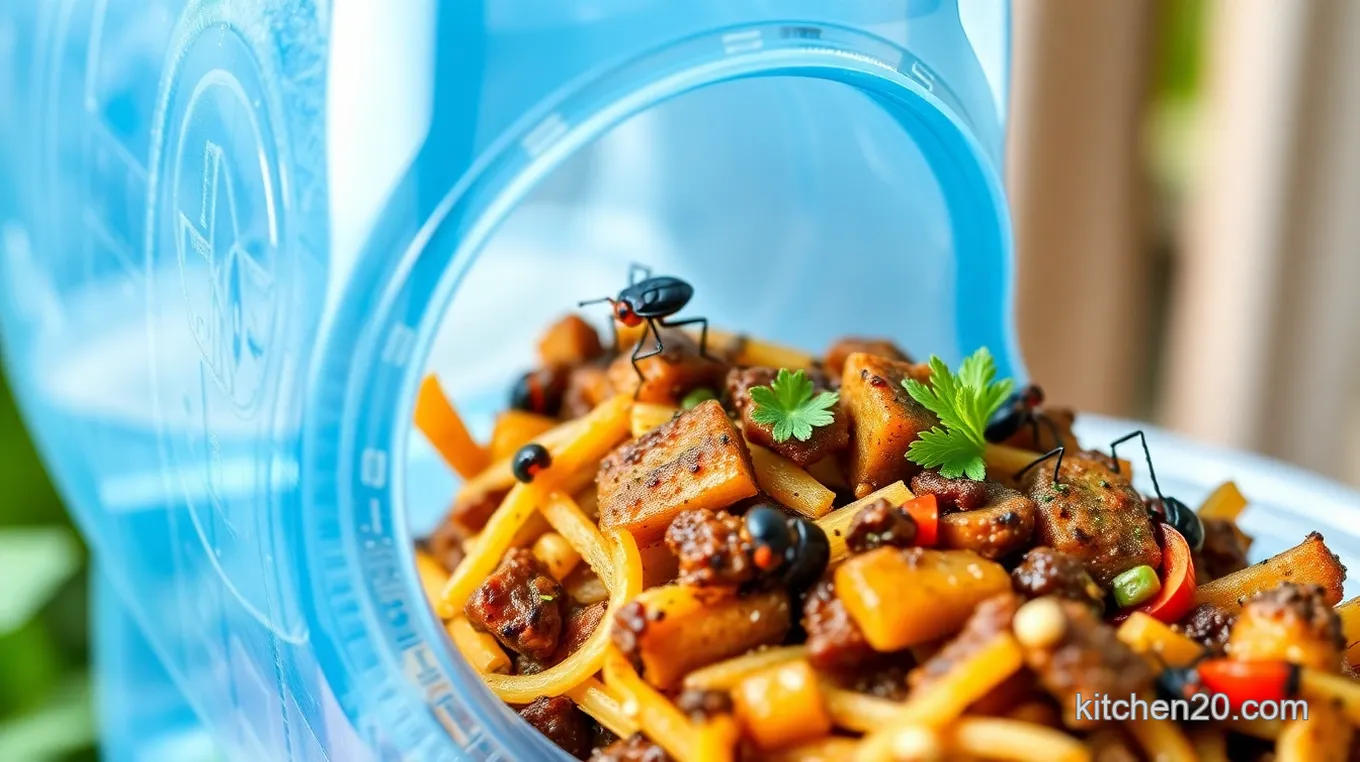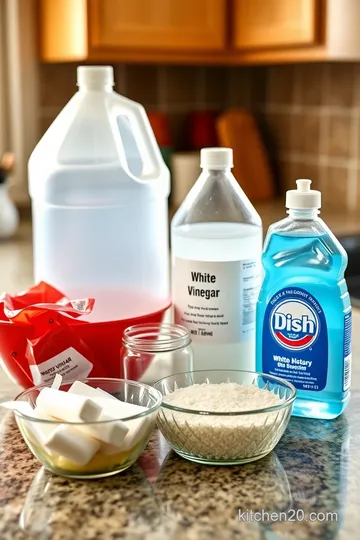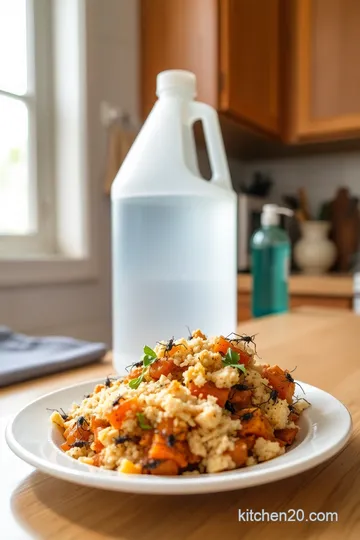Outdoor Stink Bug Trap: Your Simple DIY Guide
Struggling with stink bugs? Let me show you how to make a simple outdoor trap using vinegar and dish soap. A personal touch to eco-friendly pest control!

- Recipe Overview
- Key Benefits
- Ingredients for Your Stink Bug Trap
- Essential Ingredients Guide
- Tackling Pest Control: The Art of the Stink Bug Trap
- Pro Tips & Secrets for Your Stink Bug Trap
- Perfect Presentation for Your Trap
- Storage & Make-Ahead Tips
- Creative Variations for Your Trap
- Complete Nutrition Guide
- Expert FAQ Solutions
- Wrapping Up on Your DIY Pest Control Journey
- Recipe Card
Ever found yourself standing in your lush garden, surrounded by beauty, only to notice those pesky stink bugs creeping in? ugh! i had this moment last summer when i spent hours weeding, planting, and nurturing my beloved flowers, only to find stink bugs making a cozy home out of my hard work.
The smell? well, let’s just say it was like a bad cologne choice on a sunday morning. if you’ve ever experienced this, you know how crucial that stink bug trap outdoor becomes for garden safety!
Now, i wasn’t about to reach for heavy chemicals. i mean, who wants to douse their garden in toxic stuff, right? that’s when i rolled up my sleeves and got crafty with a diy solution.
Yep, it’s a homemade stink bug trap made from simple household items! let me share my experience with this eco-friendly pest control method and how it can keep your garden happy and healthy.
Recipe Overview
So, a bit of background: stink bugs, originally from asia, have decided to set up shop here in the good ol’ u.
S. they are now one of the common garden pests , munching on plants and ruining your harvest. but fear not! this diy pest control method, using stuff you probably already have around your house, is gaining popularity for a reason.
It’s effective, quick, and best of all—affordable.
You’ll only need about 10 minutes to whip this trap up. seriously, it’s an easy process. total no-brainer! and financially speaking, you’re looking at just a few bucks to keep those stinkers away.
One trap will usually do the trick, but if your garden is bustling with these bugs, having a few may be wise.
Key Benefits
Now, let’s dive into the juicy part—why you should care about this trap in the first place.
First off, health benefits! by using this natural insecticide , you’re opting for insect control without chemicals , making it safer for your plants and the environment.
Plus, using household items for pest control keeps it simple, and you don’t have to break the bank to protect your garden.
The unique selling point? this trap doesn’t just capture stink bugs; it does so without harming beneficial insects like bees.
It’s all about sustainable pest management here. and guess what? it’s a perfect addition for special occasions, like bbqs or garden parties when you want your guests to enjoy the outdoors without the drama of pest invasions.
You might wonder how this trap stacks up against others. let’s just say, while commercial traps can be pricey and filled with chemicals, this non-toxic pest trap does the job just as well, if not better, using techniques everyone can handle.
So, before we dive into exactly how to make this trap, let’s talk about what you’ll need. It’s super straightforward!
Ingredients for Your Stink Bug Trap
You’ll only need a few items:
- 1 large plastic bottle (2-liter works best!)
- 1 cup of water
- 1 cup of white vinegar
- ½ cup of dish soap
Trust me, you probably already have these in your kitchen!
Now that you have the goods, it's time to create your outdoor scavenger hunt for all those stink bugs. just remember, placement is key—find those hot spots where the bugs gather, like sunny corners of your garden.
With this simple yet effective trap for stink bugs , you’ll be on your way to a serene and odor-free garden. Let’s get trapping!
Ready to dig into the step-by-step instructions to make this trap? Let’s do it!

Essential Ingredients Guide
Let’s dive into some kitchen basics that can transform your cooking game. Grab a snack, get comfy, and let’s chat about the essentials that every home cook should know!
Premium Core Components
First up, premium core ingredients . it’s all about having the right stuff on hand. knowing your measurements is crucial, whether you're a fan of cups and teaspoons or prefer to go metric.
For example, a classic sugar measurement is 1 cup (200 grams). don't overthink it; just keep things simple and precise.
When shopping, look for quality indicators , like vibrant colors in your vegetables or a fresh scent in your herbs.
Fresh produce is always better and lasts longer, too. make sure to follow storage guidelines : leafy greens? wrap 'em in a damp paper towel and stick them in the fridge.
They’ll stay fresh for days!
Oh, and here’s a pro tip— shelf life matters! check expiration dates on grains and spices. and if you want to test for freshness, crush a few herbs in your fingers.
If the aroma hits you like a freight train, you’re golden!
Signature Seasoning Blend
Now, onto that magical signature seasoning blend . a well-stocked spice cabinet is like the superhero of any kitchen. mix up some essential spice combinations —think garlic powder, paprika, and black pepper.
They can elevate just about anything!
When it comes to herb pairings , consider basil with tomatoes or thyme with chicken. each herb has its own personality, and pairing them right can make a dish sing.
For flavor enhancers , don't skip on aromatics like onion and garlic. your kitchen will smell divine!
Don't forget about the regional variations of spices. For example, a little cumin is a game-changer for Mexican dishes, while curry powder can jazz up an Indian meal.
Smart Substitutions
We’ve all been there—you're halfway through a recipe, only to realize you’re out of something. no sweat! it's all about smart substitutions .
For example, out of buttermilk ? mix regular milk with a splash of vinegar.
If you’re looking to make dietary modifications , like gluten-free or dairy-free, there are plenty of alternatives. Explore plant-based options like almond flour or coconut milk—trust me, your taste buds won't complain!
And let’s talk about those emergency replacements . Running low on olive oil ? Grab some avocado oil instead. It’s all about improvisation, my friend!
Kitchen Equipment Essentials
Alright, onto the tools. you don’t need a massive kitchen to whip up something great, but knowing your must-have tools is essential.
A good knife, a sturdy cutting board, and a set of measuring cups are the holy trinity of kitchen equipment.
If you find yourself short on space, consider some alternative equipment options . a simple food processor can do the job of multiple gadgets.
Plus, don’t sleep on multi-purpose tools; they can save you a ton of room!
When prepping your dishes, a few preparation tips can go a long way. batch prep your veggies ahead of time and store them in airtight containers to save time during the week.
Speaking of storage, keep your kitchen organized for heavenly cooking experiences!
Wrap-Up & Transition
So there you have it, the essentials for tackling any recipe with confidence. before you go running off to your kitchen, let’s not forget about diy pest control ! getting rid of unwanted kitchen buddies is a must, especially in the warmer months.
If you’re battling those stinky stink bugs, why not whip up a homemade stink bug trap using easily available items? not only is it an eco-friendly pest control method, but it’s a fun little project too! you can use a vinegar stink bug solution to create an effective trap for stink bugs that’ll keep your kitchen (and garden) clear.
Just hang tight for a second—we’re about to get into the step-by-step instructions for making that trap. Trust me; a little bit of preparation goes a long way toward maintaining a pest-free home! Happy cooking and trapping, folks!
Tackling Pest Control: The Art of the Stink Bug Trap
Alright, folks! let's talk about something all gardeners deal with: pests. namely, those obnoxious little stink bugs that seem to invade out of nowhere, right? it’s like one minute you’re enjoying the lovely sun and the next you have these critters munching on your prized tomatoes! but fear not! creating a stink bug trap outdoor is a breeze, and i’ll walk you through the whole process.
Essential Preparation Steps
First things first, let’s get organized. you’ve heard the term mise en place , right? it basically means having everything ready before you start.
You want to lay out all your ingredients and tools. for this trap, gather a 2-liter plastic bottle, water, white vinegar, and some dish soap.
Oh, and you'll need scissors or a knife. safety tip: be careful when cutting the bottle. we don't want any accidents!
Now, a little time management goes a long way. honestly, this trap only takes about 10 minutes to whip up.
If you can grab a cup of coffee in that time, you can certainly do this!
Step-by-Step Process
Alright, here’s the juicy part. Follow these simple steps for your outdoor pest solutions :
- Prepare the Bottle : Cut the plastic bottle in half, leaving about one-third on the top. It makes a perfect funnel!
- Combine Ingredients : Grab a bowl and mix 1 cup of water , 1 cup of white vinegar , and ½ cup of dish soap . This combination is key!
- Assemble the Trap : Invert the top part of the bottle into the bottom and make sure it fits snugly. We want stink bugs trapped, not breaking free like some superhero movie!
- Place the Trap : Set it up in sunny spots where you’ve seen these bugs hanging out. Trust me, direct sunlight is their kryptonite!
- Monitor and Maintain : Keep checking on your trap. Empty it and refill when needed, like changing the oil in your car.
Make sure that vinegar solution stays in there because… let’s face it, stink bugs have a way of ruining our gardening vibe!
Expert Techniques
You’ve got your trap down, but here’s where we can elevate your game with some quality checkpoints .
- Temperature Control : While you don't need to worry about high or low heat here, the warmer the sun, the more effective your trap will be.
- Timing Precision : Check the trap daily. Timing is everything with pests. If it isn’t working, maybe tweak the attractant, or try adding some sugar to the vinegar .
If things aren’t going as planned, don’t fret! Even the best of us mess up. Maybe you forgot to put in the dish soap? Fix it up and try again!
Success Strategies
Now onto the common mistakes to avoid . one classic blunder? not placing the trap in high-traffic areas for stink bugs.
You want it front and center, not hiding out in the shadows.
Also, keep your trap clean! A grimy trap won’t do you any favors. Think of it like your kitchen—cleanliness is next to garden goodness.
And while we’re at it, let’s talk make-ahead options : you can easily whip up multiple traps on a Saturday morning. Just grab extra bottles and repeat the steps.
Garden Maintenance Tips
Lastly, we can’t ignore the importance of preventing insect infestations in the first place. Use natural repellents for pests like planting garlic or marigolds. They’re like your garden’s little bodyguards.
And always have a vinegar stink bug solution in your back pocket. Having a few easy homemade traps around can really help deter unwanted guests.
So there you have it! with just a few items and minimal effort, you can master the art of pest control.
This non-toxic pest trap is just waiting for you to give it a try.
Additional Information
For more tips on garden pest management and creating your own eco-friendly pest control plans check out local resources or gardening blogs.
Happy trapping—and may your garden be forever free of stink bugs!

Pro Tips & Secrets for Your Stink Bug Trap
So, you’ve made your stink bug trap outdoor masterpiece, huh? well, before you sit back and relax, let’s talk about how to level up your game with some pro tips .
First off, location matters . when placing your trap, aim for spots where those pesky bugs like to hang out—near gardens, under trees, or along sunny areas.
These guys are drawn to warmth, so sunshine is your friend !
And if you want to save some time, don’t be shy about experimenting. if you’re using a vinegar solution, try adding a bit of sugar to sweeten the deal.
Stink bugs love a sugary bait! trust me; i learned this the hard way when i forgot to entice them enough.
I ended up with a trap that just sat there looking pretty.
Lastly, keep your trap clean! Empty it out regularly, and keep it filled with that irresistible vinegar mix. A dirty trap just won’t get the job done, ya know?
Perfect Presentation for Your Trap
Now, let’s make this trap look as good as it works. i know, it’s not exactly a gourmet meal we’re talking about, but you know what? a little flair goes a long way.
Plating doesn’t always mean fancy; for our stink bug trap, think aesthetics. use a nifty stick or stake to hold your trap upright.
Not only does it look more intentional, but it also helps keep it stable in windy weather.
Now, for some garnish ideas —you can surround your trap with some pretty flowers (marigolds do a great job) or even a pop of green leaves.
This adds visual appeal and introduces natural repellents for pests . it’s a win-win!
Storage & Make-Ahead Tips
Here’s where you can think ahead. if you’re prepping multiple traps, you can mix up a bunch of your vinegar solution in advance.
Just store it in any old container , and you’ll always be ready to refill when necessary. ideally, use it up within a couple of weeks for best freshness.
Oh, and here’s the kicker: if you’re in a cool climate , make sure to bring your traps in on chilly nights.
Cold temps can make them less effective, so store ‘em somewhere cozy until the sun’s out again.
Creative Variations for Your Trap
Feeling adventurous? let’s play with flavors! you can totally tweak your trap with different attractants . besides vinegar, try using apple cider vinegar or even fruit scraps to see what draws in the most bugs.
My neighbor swears by a cocktail of sugar and beer mixed in; who knew bugs could be party animals too?
If you’re keeping an eye on the budget, make that diy pest control experience even more eco-friendly with household items.
Check your pantry—it’s amazing what you can use as natural insecticides that are safe for your garden.
Complete Nutrition Guide
Okay, so this section is a bit of a joke since our trap isn’t winning any culinary awards. but on a serious note, understanding these critters can really help you with garden maintenance tips .
Stink bugs can harm your veggies and fruits. grab some info on their lifecycle so you know when you’re most vulnerable.
Maintaining a pest-free garden means you can enjoy the health benefits of growing your own food. plus, you’ll stay on top of important dietary considerations without having to worry about what chemicals might be hiding on your produce.
Expert FAQ Solutions
And now for the fun part—let’s tackle those frequently asked questions ! a lot of people wonder why their traps aren’t getting any stink bugs.
Often, it’s just a matter of placement —remember, direct sunlight is critical!
If you find that you’re attracting more other pests before the stink bugs, don’t sweat it. it’s all part of the natural pest control journey.
Just adjust your bait or try a fresh location. and if you think you’re doing everything right and still not seeing results? don’t give up! keep tweaking until you find what works for your yard.
Wrapping Up on Your DIY Pest Control Journey
In conclusion, your stink bug trap outdoor is not just a tool; it can be a fun part of your gardening routine.
With these tips, you can turn a simple trap into a proactive pest control stance. remember, it’s all about trial and error, and before you know it, you’ll be a bug trapping pro! enjoy the process, and happy trapping!

Outdoor Stink Bug Trap: Your Simple DIY Guide Card

⚖️ Ingredients:
- 1 large plastic bottle (2-liter/68 fl oz)
- 1 cup (240 ml) water
- 1 cup (240 ml) white vinegar
- ½ cup (120 ml) dish soap (preferably unscented)
🥄 Instructions:
- Step 1: Using the knife or scissors
- Step 2: In a bowl, mix the water, white vinegar, and dish soap.
- Step 3: Take the top half of the bottle (the funnel section) and invert it into the bottom half. Ensure a snug fit to prevent stink bugs from escaping.
- Step 4: Locate your trap in areas prone to stink bug activity, ideally in direct sunlight. Pour the vinegar solution into the trap below the funnel.
- Step 5: Check the trap regularly, emptying and refilling it as necessary.
Previous Recipe: Delicious Mezcalita Recipe: How to Make the Ultimate Smoky Cocktail
Next Recipe: Cozy Starbucks Apple Crisp Chai: 5 Simple Tips for Home Bliss
